
|
Raising the Banner in Korea:
An Early Bahá'í History
by Barbara R. Sims
 |
chapter 6 | start page | single page | chapter 8 |  |
Chapter 7
7. The First Local Spiritual Assemblies in Korea, 1956
By January 1956 there were 14 new Bahá'ís in Kwangju, all mature students, and extension teaching had begun in Mokpo.In a landmark victory for the Faith the first two Local Spiritual Assemblies were elected in Korea, in Seoul and Kwangju, at Ridván 1956. They were a part of the twelve which were elected in the North East Asia area: the others were eight in Japan, one in Hong Kong, and one in Taiwan. They would form the local pillars to support the eventual National Spiritual Assembly of the Bahá'ís of North East Asia, with its seat in Tokyo, Japan.
Miss Lecile Webster, an American pioneer who worked for the U.S. Embassy in Tokyo, Japan, was transferred to Seoul that January. At that time Hand of the Cause Miss Alexander wrote to the Hands of the Cause in Asia, that "[Miss Webster's move] is surely God's Plan as it came in answer to the prayer she and Mr. Khádem said for her guidance." Mr. Smits also returned to Seoul that January after an absence of several months, during which he went to the United States and also made a pilgrimage to the Holy Land.
Miss Webster wrote to Miss Alexander of that first historic election in Seoul. Mr. Smits lit candles that he had brought from the Shrine of the Báb, following his recent pilgrimage, and he had some attar of roses given him by the Guardian for the Korean Bahá'ís. According to the report
there were nine Bahá'í men and three Bahá'í women in Seoul at that time, with eleven Bahá'ís attending the election, which was held at the residence of Mr. Suh Eton. Those elected to the Local Spiritual Assembly were Mr. William Smits (chairman), Mr. Suh Eton (vice-chairman), Dr. Lee Yong-so (treasurer), Mr. Choi Woo Yong (secretary), Mr. Yang Hee-ghon, Dr. Oh Hyon-suk, Miss Chee Hei Soon, Mr. Youn (Yun) Sok-bong, and Miss Lecile Webster. The three other adult members of the Seoul community were Mr. Chang Moon Chan, Mr. Huh Hon and Mr. Kim Chang-zin, who by this time was living in Seoul but was unable to attend the election. Miss Chee was the second Korean woman to accept the Faith.
Miss Webster left Korea the next year before Ridván.
The Local Spiritual Assembly of Seoul informed the Asia Teaching Committee of the National Spiritual Assembly of the United States that the first Bahá'í youth of Seoul, Lee Sung Yul, would be visiting the United States. Many of the early Korean Bahá'ís went to the United States to visit or study -- some stayed active but many did not.
Kwangju had twenty resident Bahá'ís at the time of their first election. According to Mr. Maxwell's report to Miss Alexander nineteen of the twenty Bahá'ís attended the election, one being out of the city. The nine Bahá'ís elected to that assembly were Mr. William Maxwell (chairman), Mr. Kim Je Hyub (treasurer), Mr. Kim Yeon Kyun (secretary), Mr. Pak Chong Huen, Mr. Oh Je Dong, Mr. Yoon Kang Joon, Mr. Im Pyoung Mo, Mr. Cho Se Hyun and Mr. Chung Hwan Kuc. Some years later Mr. Maxwell wrote that six of those members, some of whom were medical students at that time, had become highly successful physicians.
The new Kwangju Local Spiritual Assembly was quite active. They appointed eight committees and all seem to have been working. One was the Wolbo newsletter committee, with the first issue being printed in June 1956. The Assembly reported that in October they were printing 100 copies. As there was also a mimeographed Wolbo in Seoul, the Bahá'ís were able to communicate in a way that made for Bahá'í unity throughout the community in Korea.
The Assembly decided to host a Summer Conference in July. Iranian pioneers Mr. Abbas Katirai and Mr. Ataullah Moghbel attended from Japan. (Mr. Maxwell commented that they were probably the first Persians to go to Korea in modern history and when they left, all the LSA members and several other friends went five miles to the train station to see them off.) Mr. Smits, Miss Webster and two women, Dr. Oh and Miss Pang, went to the conference from Seoul. The day-time attendance varied between twenty-five and forty, with Bahá'ís constituting about half of the audience. There was one press conference with two of the largest newspapers in the area, the Chonnan Ilbo and the Honan Press. A mimeographed sheet giving basic information about the Faith had been prepared to hand out. One of the newspapers printed the equivalent of one
page in two different issues about the conference and included a photo of 'Abdu'l-Bahá.
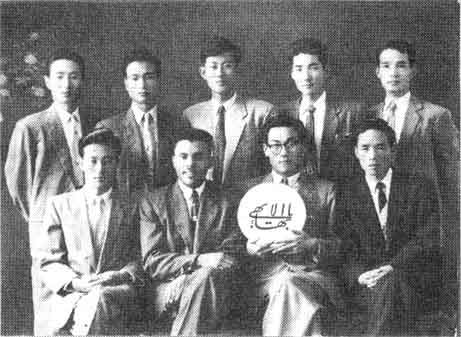
click for larger image
The first Local Spiritual Assembly of the Bahá'ís of Kwangju, elected 1956. Front: Mr. Yoon Kang Joon, Mr. William Maxwell (chairman), Mr. Kim Yeon Kyun (secretary) and Mr. Pak Chong Huen. Standing: Mr. Chung Hwan Kuc, Mr. Cho Se Hyun, Mr. Oh Je Dong, Mr. Kim Je Hyub (treasurer) and Mr. Im Pyoung Mo.
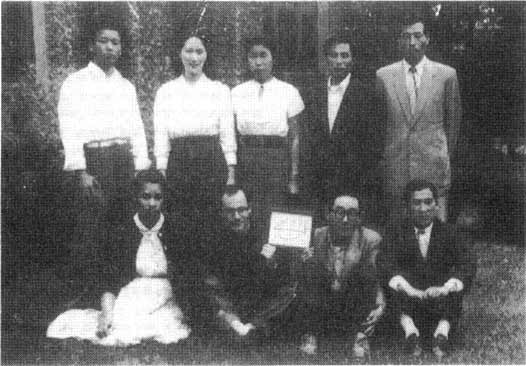
The first Local Spiritual Assembly of the Bahá'ís of Seoul, 1956. Front left to right: Miss Lecile Webster, Mr. William Smits (chairman), Mr. Suh Eton (vice-chairman) and Dr. Lee Yong-so (treasurer). Standing: Mr. Yang Hee-ghon, Dr. Oh Hyon-suk, Miss Chee Hei Soon, Mr. Choi Woo Yong (secretary) and Mr. Yun Sok-bong. Miss Chee was the second Korean woman to accept the Faith.
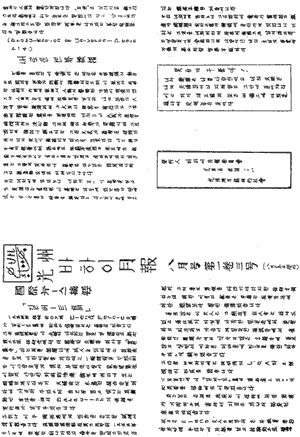
click for larger image
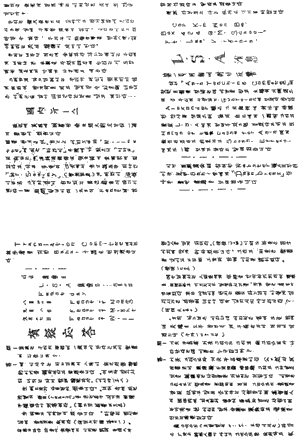
click for larger image
The Wolbo, a monthly newsletter put out by the Kwangju Local Spiritual Assembly. The first issue was June 1956. The one shown above was Vol. 1, No. 3, August 1956. The Assembly indicated that they wanted to send it to other communities in Korea. By mid-June Bahá'ís resided in four localities.

click for larger image
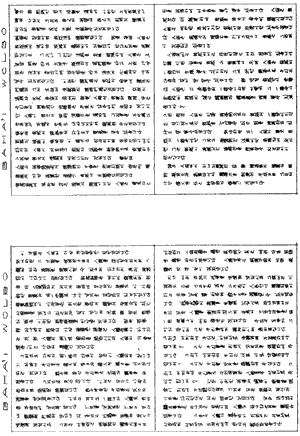
click for larger image
The Wolbo put out by the Local Spiritual Assembly of the Bahá 'is of Seoul. This one is dated December 1956. The Bahá'ís of Korea were also receiving the Japanese Bahá'í Geppo (monthly news). They were hungry for news.
A public meeting in connection with the conference had a surprisingly high attendance, mostly students, doctors, professors, and graduate students. It was estimated that at one time or another at least 100 people came to the conference, the majority being university students. The Bahá'ís considered the conference a great success and they felt that they had become infused with a new spirit.
By April 1956 there were 30 Korean Bahá'ís and three American Bahá'ís.
The Faith started expanding. By mid-1956 there were two Bahá'ís in Mokpo, one adult and one youth, and one Bahá'í in Hwason who had moved from Kwangju where he had originally become a Bahá'í. There were now four localities which had resident Bahá'ís.
It seems that the success of the Summer Conference encouraged the Kwangju community to also hold a one-week Winter Conference during the last week in December of that year. It was also a resounding success. This one had 100 people in attendance at one time or another, including the new Bahá'ís in Mokpo. Mr. Philip Marangella was able to attend from Japan where he was pioneering. According to a report, the conference provided a "boost in spiritual joy and an awareness of Bahá'í love."
 |
chapter 6 | start page | single page | chapter 8 |  |
|
|